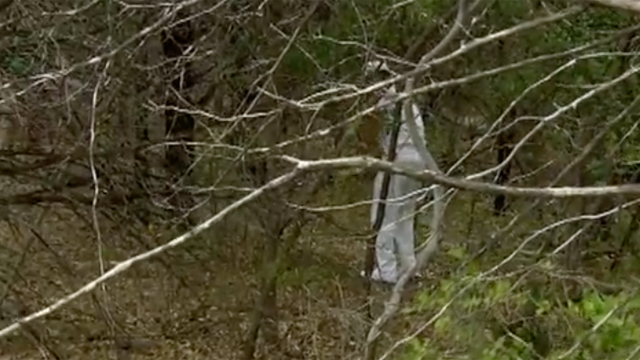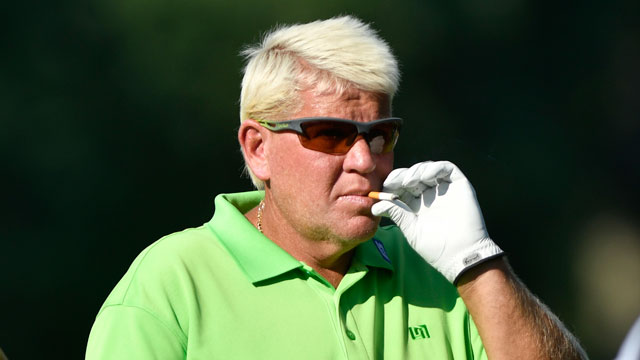NEWS
The 5 worst single-hole scores in PGA Tour history

Do you know what they call 'a mulligan' in Scotland?
"Hitting three."
Bada bing!
Anyone who plays a round of golf has at least one shot they wish they could have back. You know the one I'm talking about. It's the kind of shot that changes the complexion of a round all together. The one, bad shot that puts you in golf jail and just completely and utterly destroys an otherwise pleasant day on the links.
Well, believe it or not, that line of thinking isn't limited to just us, the average golfer. The world's best players experience this too -- especially the ones we're about to tell you about.
Here's a look at the five highest, single-hole scores in PGA Tour history:
- 23- Tommy Armor
- 19 - Hans Merrell, Dale Douglass, Ray Ainsley
- 18- John Daly
- 17- George Bayer
- 16- Kevin Na, Gary McCord, Ed "Porky" Oliver
Tommy Armour's 23

The Silver Scot is most well-known for his three major championships -- the 1927 U.S. Open, the 1930 PGA Championship and the 1931 Open Championship. But in the 1927 Shawnee Open on the par-5 17th hole at Shawnee CC, Armour recorded the first ever "Archaeopteryx" -- the term used to define a score of 15 or more over par.
Ironically, Armour's 18-over-par 23 on that par-5 hole came just one week after his U.S. Open triumph at Oakmont Country Club. So much for momentum!
RELATED: The story behind why Mike Reasor shot the highest score (123) in PGA Tour history
Hans Merrell's 19
The first of three "19s" on record, Merrell got his on the par-3 16th hole at Cypress Point during the 1959 Bing Crosby National Pro-Am. The hole played to 222 yards. It demanded a long tee shot over water, but -- believe it or not -- Merrell didn't even hit it in the Pacific Ocean.
So what happened, then?
Merrell's tee shot came up shot of the green and fell onto the beach 75 feet below. From there, his second shot was skulled into ice plant. He moved the ball just one foot with his third shot, according to an Associated Press account, and lashed at the ball four more times in the ice plant before it was buried and therefore unplayable.
RELATED: Here's how the 'Mulligan' got its name
He took a drop on the beach and hit the ball back into ice plant, trying unsuccessfully many more times to extract it. After a third drop, he finally found the green and two-putted from 20 feet for the 19.
Dale Douglass's 19

On the final day of the 1963 Bing Crosby National Pro-Am, Douglass took a crushing 19 on the par-4 10th hole at Pebble Beach Golf Links.
It all started when Douglass sliced his tee shot onto the beach. He took three, unplayable lies and a bunch of swings before finally getting back to the fairway where he was lying 14.
His 15th shot went into a greenside bunker. Two shots and two putts later, he had his 19. Remarkably, Douglass played his final eight holes in even par... and shot a 92 that day.
"It's kind of a blur," Douglass told the L.A. Times. "I know my tee shot lodged in the bank of a cliff. I tried to hit it about three times. Finally it rolled back to the beach and an unplayable lie. I took the first of about eight penalty strokes.
"Every time I hit the ball it would slash into the bank and roll back to be half buried. Finally I had to put it on a piece of ice plant to hit it out of there. Joe Campbell was playing with me and helped me count the strokes. I just can't remember all of them. I was trying my best on all the shots, but you just couldn't get any footing."
In 1969, Douglass was a runner-up to George Archer in the event. Go figure.
Ray Ainsley's 19
This might be the biggest example of "not understanding the rules" on this list. Ainsley, a club professional from California, ran into his 19 during the second round of the 1938 U.S. Open at Cherry Hills Country Club in Denver on the par-4 16th.
Evidently, Ainsley's approach shot faded on its way to the green and ended up in a creek. He repeatedly hit his submerged ball, trying -- but failing -- to get it out of the water. Eventually he sent a shot out of the water and into some tree trouble.
He got up and down from that spot for a 19.
When a rules official asked Ainsley why he didn't take a drop in the first place, Ainsley conceded that he thought he had to "play the ball as it lay all the time."
Oops.
John Daly's 18

Of the 26 scores of "13" or higher in PGA Tour history, three of them belong to two-time major winner John Daly. But, it was his 18 on the 16th hole at Bay Hill in the 1998 Bay Hill Invitational that was the worst of the bunch.
On this fateful day for Daly, it all began when his tee shot found the lake on the left side of the 543-yard par 5. Armed with a three-wood after taking his drop where the ball crossed the hazard, Daly proceeded to -- Tin Cup-style -- hit five consecutive shots into the drink.
Daly eventually cleared the water with his sixth attempt, but the Golf Gods weren't done messing with him yet. The ball embedded into a bank and he was forced to drop the ball again.
From Clifton Brown in a New York Times story that day:
The seven shots plus the seven penalty strokes already gave him a score of 14. Daly's next shot was a 6-iron, and it barely cleared the water that is in front of the green, hitting the rocks that line the water and then ricocheting into the sand trap near the green.
Daly blasted out of the sand, then two-putted for his 18. After starting the hole two under par for the tournament, he walked off 11 over.
Amazingly, Daly made birdie on the next hole, and he shot a 49 on the front side and a 36 on the back side for an 85. With that score, he plummeted off the leader board into a tie for 53d place with a four-round total of 298 -- a 68 in the first round followed by a 75, a 70 and an 85.
George Bayer's 17

Bayer is a four-time PGA Tour winner, who -- unbelievably -- didn't take up the game professionally until the age of 29 after a career as a football player.
The towering 6'5", 230-pounder who would win the 1963 Par 3 Contest at the Masters, made his 17 on the 17th hole at Seneca Golf Club in the 1957 Kentucky Derby Open. And it was all in a fit of rage.
Bayer, disgusted with his play, chipped his ball all the way down the fairway with a 7-iron on his way to the 17. He would wind up posting a 90.
For his "unsportsmanlike conduct" the PGA Tour initially gave Bayer a 30-day suspension. It was later reduced to a $200 fine, and a 90-day probation.
Kevin Na's 16
The most recent of the PGA Tour's highest, single-hole scores, came courtesy of Na on the ninth hole -- a 474-yard, par 4 -- at TPC San Antonio during the 2011 Valero Texas Open.
The best part about this train-wreck? It just so happened that Na was wearing a microphone during the telecast that day.
After hitting a second tee shot into the woods, we enjoyed the following exchange.
"What are the chances of me getting out of here?" Na asked his caddie.
"About 50/50."
Wrong.
The next shot actually hit a tree and came back to hit Na in the leg -- good for a penalty.
Twelve shots later, including a left-handed whiff, Na was back in play. He one-putted once he got to the green.
Gary McCord's 16

You know him as the funny man behind the mic on CBS golf broadcasts. But, before that, McCord spent time on the PGA Tour.
That includes the 1986 St. Jude Classic, when he made a 16 on the 16th hole at Colonial CC (South).
On the par-5 hole, McCord hit five 4-iron shots into the water.
Then it dawned on him that he'd been using the wrong club. So McCord switched to a 3 iron, found the green and canned a 25-footer for an 11-over 16.
"I'm looking right between the eyes at a 17 if I don't make that putt," McCord said at the time. "I was determined to make it."
Ed "Porky" Oliver's 16

An eight-time PGA Tour winner, Oliver was another victim of the treacherous par-3 16th hole at Cypress Point. He made a 16 there in the 1954 Bing Crosby Pro-Am, 14 years after he won the tournament.
In Oliver's defense, there was a 50 mph wind blowing at the time according to an account of the day.
